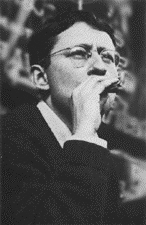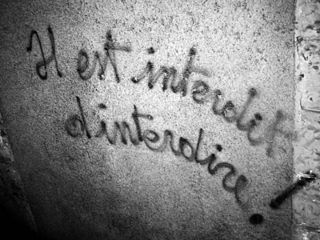
The Situationist International (SI) was an international organization of social revolutionaries made up of avant-garde artists, intellectuals, and political theorists. It was prominent in Europe from its formation in 1957 to its dissolution in 1972. The intellectual foundations of the Situationist International were derived primarily from libertarian Marxism and the avant-garde art movements of the early 20th century, particularly Dada and Surrealism. Overall, situationist theory represented an attempt to synthesize this diverse field of theoretical disciplines into a modern and comprehensive critique of mid-20th century advanced capitalism.

Guy-Ernest Debord was a French Marxist theorist, philosopher, filmmaker, critic of work, member of the Letterist International, founder of a Letterist faction, and founding member of the Situationist International. He was also briefly a member of Socialisme ou Barbarie.

The Letterist International (LI) was a Paris-based collective of radical artists and cultural theorists between 1952 and 1957. It was created by Guy Debord and Gil J. Wolman rejoined by Jean-Louis Brau and Serge Berna as a schism from Isidore Isou's Lettrist group. The group went on to join others in forming the Situationist International, taking some key techniques and ideas with it.

Psychogeography is the exploration of urban environments that emphasizes interpersonal connections to places and arbitrary routes. It was developed by members of the Letterist International and Situationist International, which were revolutionary groups influenced by Marxist and anarchist theory as well as the attitudes and methods of Dadaists and Surrealists.
COBRA or Cobra, often stylized as CoBrA, was a European avant-garde art group active from 1948 to 1951. The name was coined in 1948 by Christian Dotremont from the initials of the members' home countries' capital cities: Copenhagen (Co), Brussels (Br), Amsterdam (A).
Lettrism is a French avant-garde movement, established in Paris in the mid-1940s by Romanian immigrant Isidore Isou. In a body of work totaling hundreds of volumes, Isou and the Lettrists have applied their theories to all areas of art and culture, most notably in poetry, film, painting and political theory. The movement has its theoretical roots in Dada and Surrealism. Isou viewed his fellow countryman Tristan Tzara as the greatest creator and rightful leader of the Dada movement, and dismissed most of the others as plagiarists and falsifiers. Among the Surrealists, André Breton was a significant influence, but Isou was dissatisfied by what he saw as the stagnation and theoretical bankruptcy of the movement as it stood in the 1940s.

Asger Oluf Jorn was a Danish painter, sculptor, ceramic artist, and author. He was a founding member of the avant-garde movement COBRA and the Situationist International. He was born in Vejrum, in the northwest corner of Jutland, Denmark, and baptized Asger Oluf Jørgensen.
List of people that, at different times, have been members of the Situationist International:

Constant Anton Nieuwenhuys, better known as Constant, was a Dutch painter, sculptor, graphic artist, author and musician.
Walter Olmo was an Italian musician and composer. In 1957 he wrote Towards a Conception of Musical Experimentation. He advocated avant-garde electronic and contemporary music. In his 1975 he published the essay La fine della preistoria musicale.
Piero Simondo was an Italian artist born in Cosio di Arroscia, Liguria, Italy.

The dérive is an unplanned journey through a landscape, usually urban, in which participants stop focusing on their everyday relations to their social environment. Developed by members of the Letterist International, it was first publicly theorized in Guy Debord's "Theory of the Dérive" (1956). Debord defines the dérive as "a mode of experimental behaviour linked to the conditions of urban society: a technique of rapid passage through varied ambiances."

Unitary urbanism (UU) was the critique of status quo "urbanism", employed by the Letterist International and then further developed by the Situationist International between 1953 and 1960.

The Second Situationist International were a small group of situationists who broke away from the Situationist International (SI). Jørgen Nash identifies the first manifestation of the group as a leaflet signed by himself along with Jacqueline de Jong and Ansgar Elde, shortly after the group Seven Rebels was formed at Situationist Bauhaus at Asger Jorn's farm Drakabygget in southern Sweden.

Giuseppe Pinot-Gallizio (1902–1964) was an Italian painter, the formulator of industrial painting, and a founding member of the Situationist International. He was also a scholar of popular culture, archaeology, nomadism, and botany.

Cosio di Arroscia is a comune (municipality) in the province of Imperia in the Italian region Liguria, located about 100 kilometres (62 mi) southwest of Genoa and about 25 kilometres (16 mi) northwest of Imperia.
Gil Joseph Wolman was a French artist. His work encompassed painting, poetry and film-making. He was a member of Isidore Isou's avant garde Letterist movement in the early 1950s, then becoming a central figure in the Letterist International, the group which would subsequently develop into the Situationist International.

Report on the Construction of Situations is the founding Manifesto of the Situationist International revolutionary organization. The pamphlet was published by Guy Debord in June 1957, and the following month the organization was founded in Cosio d'Arroscia, Italy.

Museum Jorn, Silkeborg, is an art museum located by Gudenåen in Silkeborg, Denmark. The museum holds the collections that were developed by Asger Jorn (1914–1973) from the early 1950s until his death in 1973, since when they have doubled in extent.

Sergio Dangelo was an Italian surrealistic painter and illustrator. He was the founder of the Arte nucleare movement, part of the nuclear art tendency, and was a co-founder of the International Movement for an Imaginist Bauhaus.










